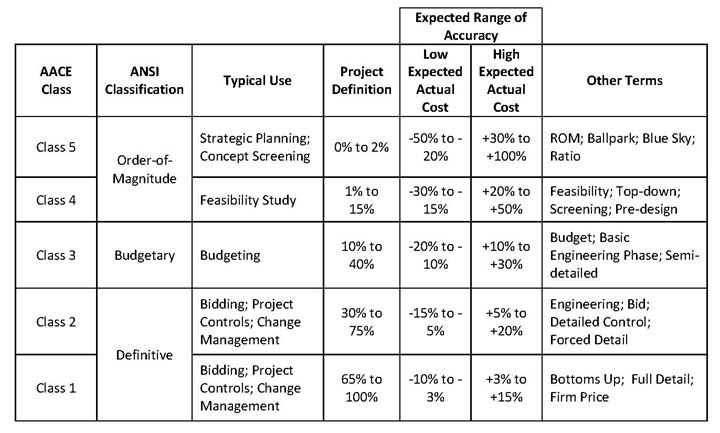Capital Cost Estimate Classes
Different levels of capital cost estimates provide key input for decisions over the life of surface finishing projects.
Whether building new process lines or renovating existing lines, capital and operating and maintenance (O&M) cost estimates are important for project planning and implementation. The following is part one in a series that will provide an overview of capital cost estimates classes.
Different levels of capital cost estimates provide key input for decisions over the life of surface finishing projects — from initial concept development through project selection and budgeting and on through completion of engineering design, procurement and implementation phases. Understanding cost estimating methods and expected ranges of accuracy over a typical project life cycle is important for project financial considerations, communications and decision support.
Table 1 is adapted from the AACE International practice guideline 18R-97, which applies the principals of cost estimating classification for process industry engineering, procurement and construction projects. This guideline is applicable for surface finishing process projects. Table 1 shows five AACE cost estimate classifications with the following information and characteristics:
- Comparison of the five AACE classes to the three traditional, widely used ANSI cost estimate classifications.
- Typical uses of each class of estimate for support, from project conceptualization and development through project delivery and completion.
- Level of project definition, expressed as a percentage of engineering and general project (for example, scope, schedule, work breakdown structure, contracting strategy, escalation strategy) documentation development. For process projects, the engineering development typically progresses:
- From early definition, including project location and constraints, general scope, processes and chemistries, production requirements and work envelopes, and process flow diagrams (PFDs).
- Through process layouts and implementation phasing plans (if applicable), piping and instrument diagrams (P&IDs), utility flow diagrams, mass and energy balances, building integration plans, and equipment schedules.
- Through detailed, multidiscipline engineering plans (structural, mechanical, electrical, I&C) and drawings (3D and 2D), specifications and data sheets, functional descriptions, O&M and commissioning plans, and lists of spare parts included in the project.
- Expected Range of Accuracy: The accuracy ranges for each estimate class represent a range around an estimated expected cost value for a specific scope, including appropriate contingencies. The +/- percentage ranges represent an 80% confidence interval that completed actual project costs for a given scope will fall within the estimated ranges (assuming project implementation at specific location, under planned schedule and more). For each estimate class, the ranges for the low expected actual cost and high expected actual cost represent typical variances that result from individual project complexity and level of definition. These ranges also vary with estimating methods, engineering and estimating experience applicable for a specific surface finishing project. The ranges are asymmetric with higher percentage variations for the high costs. This is due to historical cost outcomes for specific project scopes that demonstrate factors combined to make the magnitude of probable final project cost increases from estimated values more likely than cost decreases.
- Other Terms: These other commonly used estimate names are approximately correlated with the AACE estimate classes. Use of these other terms is not always specified with expected ranges of accuracy and may differ in meaning for different circumstances.

TABLE 1: Summary of AACE International Cost Classifications and Expected Ranges of Accuracy.
In progressing from AACE Class 5 to Class 1 estimates, methodologies typically begin with more stochastic approaches (for example, estimating from previous similar project costs using parametric calculations based on key quantities) and transition to more complete deterministic methodologies (for example, semidetailed to full line item detailed estimates). Appropriate contingencies are assumed to be included in each AACE estimate class. Contingencies are separate from allowances. Contingencies account for nonspecific/uncertain scope items and project risks. Contingencies are best estimated based on experience and review of similar past project estimated scope and costs compared to completed project actual costs with the same scope. When known scope items for a planned project are not included in stochastic extrapolations or are not yet accounted for in line item cost details, specific allowances should be included in estimates for these known but mostly unquantified scope items (for example, existing process demolition that was not part of a previous project used for a Class 5 estimate where the new project has process demolition; interconnecting process electrical or mechanical not yet detailed in a Class 4 or 3 estimate and more).
__________________________________________________
Peter Gallerani is president and chief technology officer at Integrated Technologies, Inc., an engineering, design and consulting solutions firm based in Burlington, Vermont, that offers project planning and development, full-service engineering and design, project and construction management, and services during construction to the surfacing finishing and industrial manufacturing industries. Visit processengineer.com
Related Content
An Overview of Electroless Nickel Plating
By definition, electroless plating is metal deposition by a controlled chemical reaction.
Read MoreInnovation in Plating on Plastic
Plating on advanced plastics solution offers improved adhesion, temperature resistance and cost savings.
Read MoreProducts Finishing Reveals 2024 Qualifying Top Shops
PF reveals the qualifying shops in its annual Top Shops Benchmarking Survey — a program designed to offer shops insights into their overall performance in the industry.
Read MoreSuccessful South African Plater Beating the Odds
Remaining focused on quality and reliability, Team Plating Works stays profitable in a volatile and challenging economy.
Read MoreRead Next
Episode 45: An Interview with Chandler Mancuso, MacDermid Envio Solutions
Chandler Mancuso, technical director with MacDermid Envio discusses updating your wastewater treatment system and implementing materials recycling solutions to increase efficiencies, control costs and reduce environmental impact.
Read MoreA ‘Clean’ Agenda Offers Unique Presentations in Chicago
The 2024 Parts Cleaning Conference, co-located with the International Manufacturing Technology Show, includes presentations by several speakers who are new to the conference and topics that have not been covered in past editions of this event.
Read MoreDelivering Increased Benefits to Greenhouse Films
Baystar's Borstar technology is helping customers deliver better, more reliable production methods to greenhouse agriculture.
Read More












.jpg;maxWidth=300;quality=90)








